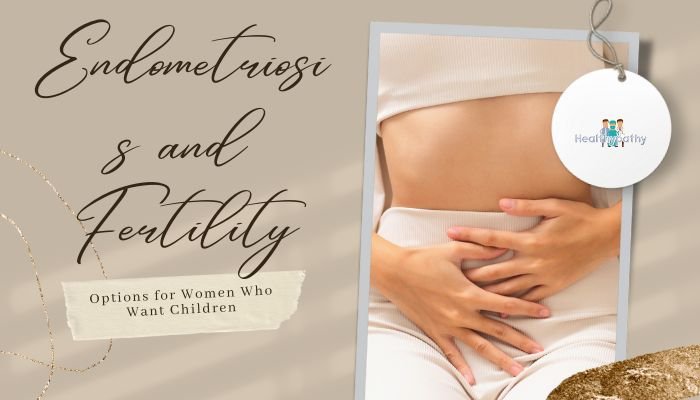Introduction
Endometriosis is a gynecological condition in which tissue resembling the uterine lining (the endometrium) grows outside the uterus, often on the ovaries, fallopian tubes, or other pelvic tissues. Beyond causing pain, heavy periods, and digestive discomfort, endometriosis can also affect fertility. However, having endometriosis doesn’t automatically mean you can’t conceive.
Women with this condition can become pregnant naturally or with assistance. This article discusses how endometriosis influences fertility, the steps to take when trying to conceive, and what treatments or advanced options may help in achieving pregnancy.
How Endometriosis Affects Fertility
Distorted Pelvic Anatomy
When endometrial lesions, adhesions, or cysts (endometriomas) develop, they can distort the normal pelvic structure. The fallopian tubes or ovaries may be displaced or blocked, hindering egg pickup or fertilization. Inflammation from these lesions can also impair egg quality and sperm-egg interaction.
Hormonal and Immune Factors
Endometriosis often involves inflammatory responses, with elevated cytokines and immune cells in the pelvis. These changes might hamper the fertilization process or embryo implantation. Meanwhile, hormonal imbalances linked to endometriosis could further complicate ovulation or endometrial receptivity.
Symptoms and Stress
Chronic pain and heavy bleeding can create emotional and physical strain. Stress from managing endometriosis may inadvertently affect hormonal balance, sexual activity frequency, or willingness to attempt conception in each cycle.
Diagnosis and Initial Steps
Medical Evaluation
If you have endometriosis or suspect it, speak with a healthcare provider—especially if you’re trying to conceive without success. Diagnosis often involves:
- Pelvic Exam: Checking for masses or tenderness.
- Ultrasound or MRI: Imaging that might identify endometriomas or large adhesions.
- Laparoscopy: A minimally invasive surgical procedure offering both diagnosis and possible removal of lesions.
Fertility Assessment
To evaluate fertility potential, your care team may suggest:
- Blood Tests: Hormone levels (FSH, LH, AMH) and overall ovarian reserve status.
- Semen Analysis (for partnered couples)
- Hysterosalpingography (HSG): An X-ray test to check tubal patency if indicated.
Managing Endometriosis for Better Fertility
Pain and Symptom Control
Managing pain and inflammation can alleviate stress and potentially boost chances of conception:
- Medications: NSAIDs, hormonal treatments (like oral contraceptives) used for pain may help initially, though many are not indicated when actively trying to conceive.
- Lifestyle Adjustments: Balanced diet, stress-reducing techniques, and moderate exercise support hormone equilibrium and overall health.
Surgical Intervention
Some women benefit from laparoscopic surgery to remove endometriotic lesions or cysts, potentially restoring more normal pelvic anatomy. However:
- Surgery Approach: A conservative technique that preserves ovarian tissue (and therefore fertility) is key. Overly aggressive surgery can reduce ovarian reserve.
- Timing: Post-surgery, fertility often improves for a window. Conceiving during this timeframe may enhance success chances.
Fertility Treatment Options
Ovulation Induction and Intrauterine Insemination (IUI)
For milder endometriosis without severe anatomical distortion, doctors may propose:
- Ovulation-Stimulating Medications (e.g., clomiphene citrate or letrozole) to increase the number of eggs.
- IUI to place sperm directly into the uterus during peak fertility, bypassing potential minor tubal or cervical issues.
In Vitro Fertilization (IVF)
When moderate to severe endometriosis or other factors complicate fertility, IVF can offer higher success rates:
- Stimulation: Medications prompt multiple eggs to mature.
- Egg Retrieval: Eggs are collected from the ovaries.
- Fertilization: Eggs meet sperm in a lab, producing embryos.
- Embryo Transfer: A healthy embryo is placed into the uterus.
Although IVF is often more expensive and time-intensive, it circumvents some mechanical barriers (blocked tubes, pelvic scarring) that hamper natural conception.
Egg or Embryo Freezing
If recurring surgeries or uncertain future fertility are concerns, freezing eggs or embryos prior to more advanced endometriosis or extensive surgeries can preserve the option of pregnancy later—particularly for women in their 20s or early 30s.
Donor Options or Surrogacy
In extreme cases where ovarian function or the uterine environment is severely compromised, using donor eggs or a gestational surrogate might be considered. This route often arises for advanced or refractory endometriosis.
Self-Care and Support
Stress Management
Fertility challenges can amplify emotional stress. Counseling, support groups, or mind-body techniques (e.g., yoga, meditation) help maintain emotional resilience.
Healthy Lifestyle Choices
- Diet: Emphasize anti-inflammatory foods (fruits, vegetables, whole grains, omega-3 sources).
- Exercise: Gentle but regular physical activity—like walking or low-impact workouts—improves circulation and mood, aiding hormone regulation.
- Maintain a Healthy Weight: Overweight or underweight extremes can disrupt fertility further.
Monitoring Cycles
Tracking ovulation using basal body temperature charts, apps, or ovulation predictor kits can complement medical treatments and facilitate well-timed intercourse or planned fertility interventions.
Consult Your Care Team
Collaborative Approach
Given endometriosis’s complexity, you may benefit from a multidisciplinary team—including gynecologists, reproductive endocrinologists, and pelvic pain specialists. They can coordinate medication, potential surgeries, or advanced ART (assisted reproductive technology).
Follow-Up and Adjustments
Fertility journeys seldom follow a single, linear path. Stay open to adjusting your treatment plan—be it changing medication protocols, scheduling laparoscopic surgery for lesion removal, or moving from IUI to IVF if you’re not achieving desired results.
Conclusion
Though endometriosis can complicate conception, numerous medical and surgical strategies help many women achieve pregnancy. From lifestyle adjustments and pain management to advanced fertility treatments like IVF, a variety of pathways exist to address both endometriosis and fertility goals. Communication with a knowledgeable healthcare provider is essential—particularly in deciding if conservative surgery could restore normal pelvic anatomy or if direct IVF is more suitable. Ultimately, an individualized plan that balances symptom control and reproductive aspirations can help women with endometriosis pursue parenthood successfully.
References
- American Society for Reproductive Medicine (ASRM). Endometriosis and Infertility: Clinical management guidelines. 2021.
- European Society of Human Reproduction and Embryology (ESHRE). Endometriosis guidelines. 2022.
- Practice Committee of the American Society for Reproductive Medicine. Management of infertility due to endometriosis. Fertil Steril. 2018;110(6):926–938.
- Giudice LC, Kao LC. Endometriosis. Lancet. 2004;364(9447):1789–1799.
- National Institute of Child Health and Human Development (NICHD). Endometriosis and fertility treatment options. 2020.






